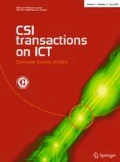Abstract
Owing to the continual attacks by pests particularly the bark-beetles (viz borers), there has been tremendous destruction of the forest resources. Beetle attacks are also responsible for severe production loss in commercial crops, thus leading to distress to farmers. In this paper, we have presented a novel approach to detect the pest attack in yielding cashew trees at early stage, i.e. to develop a portable unit. The preliminary analysis of bark samples (taken at height of 1.5 meter) shows a clear distinction between the good and infested trees. Also, the chlorophyll analysis performed on leaf samples shows the result for good and different stages of infestation as decrease in absorbance values of the leaf extract. The proposed design will indicate the status of a cashew tree by analysing the chlorophyll content of leaves and conductivity of bark, both of which will be utilised to make an ultimate confirmation.



Similar content being viewed by others
References
Hofstetter RW, Mahfouz JB, Klepzig KD, Ayres MP (2005) Effects of tree phytochemistry on the interactions among endophloedic fungi associated with the southern pine beetle. J Chem Ecol 31(3):539–560
Moraal LG (2010) Infestations of the cypress bark beetles phloeosinus rudis, p. bicolor and p. thujae in the netherlands. J Chem Ecol 31(3):539–560
Berg AR, Heald CL, Hartz KEH, Hallar AG, Meddens AJH, Hicke JA, Lamarque J-F, Tilmes S, Tilmes S (2013) The impact of bark beetle infestations on monoterpene emissions and secondary organic aerosol formation in western north america. Atmos Chem Phys 13(6):3149–3161
Zhao T, Axelsson K, Krokene P, Borg-Karlson A-K (2015) Fungal symbionts of the spruce bark beetle synthesize the beetle aggregation pheromone 2-methyl-3-buten-2-ol. J Chem Ecol 41(9):848–852
Do pine beetle fan the flames in western forest.mp4. https://www.youtube.com/watch?v=d8TCT5UkjaU. Accessed 20 Sep 2015
Puttur-574202. The Director, Directorate of Cashew Research. Nrcc technical bulletin no. :11, march 2012,
Meddens AJH, Hicke JA, Vierling LA, Hudak AT (2013) Evaluating methods to detect bark beetle-caused tree mortality using single-date and multi-date landsat imagery. Remote Sens Environ 132:49–58
Ortiz SM, Breidenbach J, Kndler G (2013) Early detection of bark beetle green attack using terrasar-x and rapideye data. Remote Sens 5(4):1912–1931
Chen Y, Why A, Batista G, Mafra-Neto A, Keogh E (2014) Flying insect classification with inexpensive sensors. J Insect Behav 27(5):657–677
Gohokar VV, Mundada RG (2013) Detection and classification of pests in greenhouse using image processing. J Electron Commun Eng 5(6):57–63
Leininger TD, Schmoldt DL, Tainter FH (2001) Using ultrasound to detect defects in trees: current knowledge and future needs. Proc Int Precision For Coop Symp 1:99–107
Conductivity Theory and Measurement, Technical Notes 4-1. https://iccontrols.com/art-4-1_conductivity_theory_and_measurement. Accessed 15 Oct 2015
Conductivity theory practice. http://www.analytical-chemistry.uoc.gr/files/items/6/618/agwgimometria_2.pdf. Accessed 15 Oct 2015
Conductivity Probe Order Code CON-BTA. http://www.scientrific.com.au/PDFs/Vernier/con-bta.pdf. Accessed 15 Oct 2015
Theory and application of conductivity. http://www2.emersonprocess.com/siteadmincenter/PM%20Rosemount%20Analytical%20Documents/Liq_ADS_43-018.pdf. Accessed 15 Oct 2015
The basics of chlorophyll measurement. http://www.ysi.com/media/pdfs/T606-The-Basics-of-Chlorophyll-Measurement.pdf. Accessed 15 Oct 2015
Misra N, Misra M, Singh R (2012) Chlorophyll Fluorescence in Plant Biology, InTech, pp 171–192.
Suhandono S, Viridi S, Kesuma T, Shibghatallah MAH, Khotiah SN, . Measuring leaf chlorophyll concentration from its color: a way in monitoring environment change to plantations https://doi.org/10.1063/1.4820322
Tett P, Kelly MG, Hornberger GM (2000) A method for the spectrophotometric measurement of chlorophyll a and pheophytin a in benthic microalgae. Limnol Oceanogr 20(5):887
Author information
Authors and Affiliations
Corresponding author
Rights and permissions
About this article
Cite this article
Venkatraman Prabhu, Y., Parab, J.S., Gad, R.S. et al. Farmer-friendly portable system for diagnosis of pest attack in cashew trees. CSIT 6, 215–219 (2018). https://doi.org/10.1007/s40012-018-0198-8
Received:
Accepted:
Published:
Issue Date:
DOI: https://doi.org/10.1007/s40012-018-0198-8




